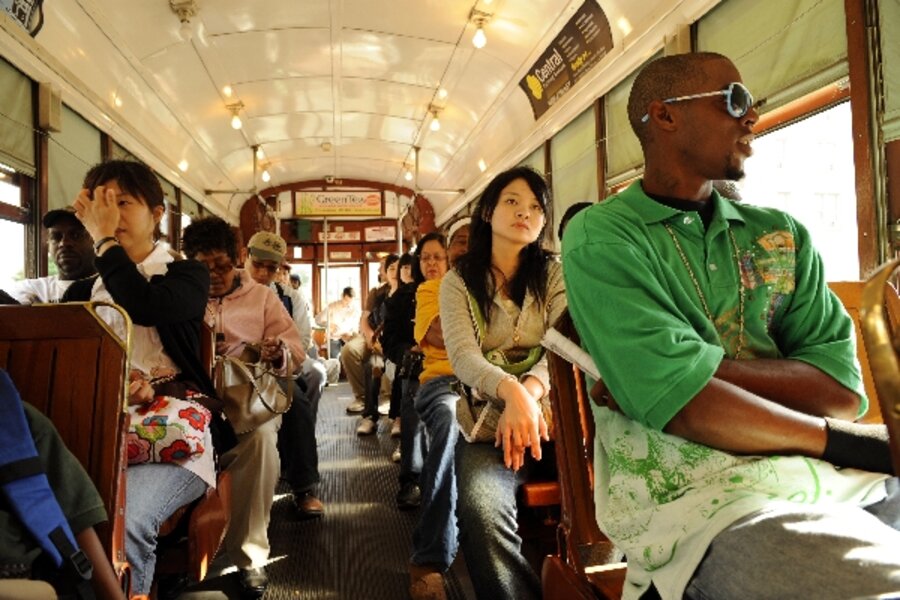United States: A streetcar named nostalgia
Loading...
• A local, slice-of-life story from a Monitor correspondent.
NEW ORLEANS – We board way out on St. Charles Street as old 923 ratchets to a stop. A crescent moon has just disappeared, and a sweet prevailing breeze is kicking up, flowing through hardwood windows that open easily. $1.25 later, the electric engine thrums and the 923 cranks into gear, lurching confidently into a city defined by danger and opportunity, tempered by an undying urge to let the good times roll.
Tennessee Williams almost named his famous play “The Poker Night,” but fortunately he stumbled onto “A Streetcar named Desire” instead. Yes, the old “Desire St.” line is gone, perhaps forever. But today, if not for hurricane Katrina’s wallop, the New Orleans’ streetcar system would be the oldest continuously operated streetcar system in the world.
For many New Orleanians, the future of the city lies in its past – half a century before the hurricane hit. Talk is of tearing down the elevated interstates that came with urban renewal and digging up the maze of old streetcar lines that lay buried under asphalt.
Don’t just restore the streetcars from Katrina’s touch, the thought goes, expand the lines to their original egalitarian glory. For once, New Orleans is ahead of the curve: Nearly 100 US cities now are considering streetcar lines, according to the Lincoln Institute of Land Policy in Cambridge, Mass.
Although the city has its red streetcar line – modern, mechanically cooled, and with welded tracks – locals still prefer the rough, noisy, and naturally air-conditioned ride of the green cars, lit at night by bare bulbs. Riders of the green streetcars say the system’s sturdy presence helps to hasten the Big Easy’s return, even as it slows the city’s pace and synchronizes the New Orleans existence to a steady, but calming clank and sway – a little more like riding a small ferry than a motorized car. Comfort in muggy New Orleans is always relative.
Unlike other cities, New Orleans never fully embraced modern streetcars, and the mechanics at the old Carrollton depot are adept at machining parts to keep the stock rolling. It took a $46 million federal grant to repair the newer red cars after they were flooded. They began operation again earlier this year. The old green clunkers weren’t touched by the flood – paragons of practical simplicity that began rolling as soon as the catenary was fixed.
In a city where rules are meant to be bent, modern mass-transit safety notions are blithely ignored as riders crowd the driver, who stands with both hands on levers that accelerate and brake the car and converses freely as it clanks, shimmies, and rocks past the ornate mansion fronts of St. Charles.
A pedal kick by the driver clangs a bell. A woman braids her daughter’s hair as a boy toddler and a girl baby lean quietly against her on the wooden seats, lulled by the motion. Japanese tourists, lanky teenagers in too-big white T-shirts, and skateboarders also crowd in and enjoy the ride. The one rule to obey, however, is: Don’t hang your head or arms out the windows. Trees, lampposts, and trucks provide a tight squeeze.
The streetcar lines that travel up St. Charles and Canal Streets serve as a metronome for a city that is systematically getting back up on its feet. The system epitomizes not just New Orleans’ charm, but also its stubborn anachronisms – values that have a curious draw on a new generation of socially conscious young Americans who’ve been flocking to the Big Easy looking for work and a life in one of the only major US cities with positive employment trends.
Marco Baldecci’s nose is deep into Dr. Spock’s baby book, a clue to the anxious wrinkle across his brow. Since the young professional moved here last year, he rides the green streetcars nearly every day from his Uptown house to his downtown job. “It’s elegant and old-fashioned,” Mr. Baldecci says, “not to mention practical.”
The 923 – built in the 1920s in High Point, N.C., back when American welders still built trains and trolleys – turns from St. Charles and charges into the steep valleys of the downtown. Bourbon Street and all its attendant sights and smells beckons beyond. Riders smile gently, and thank the driver, who tips his hat. There is joy in Mudville, after all.





